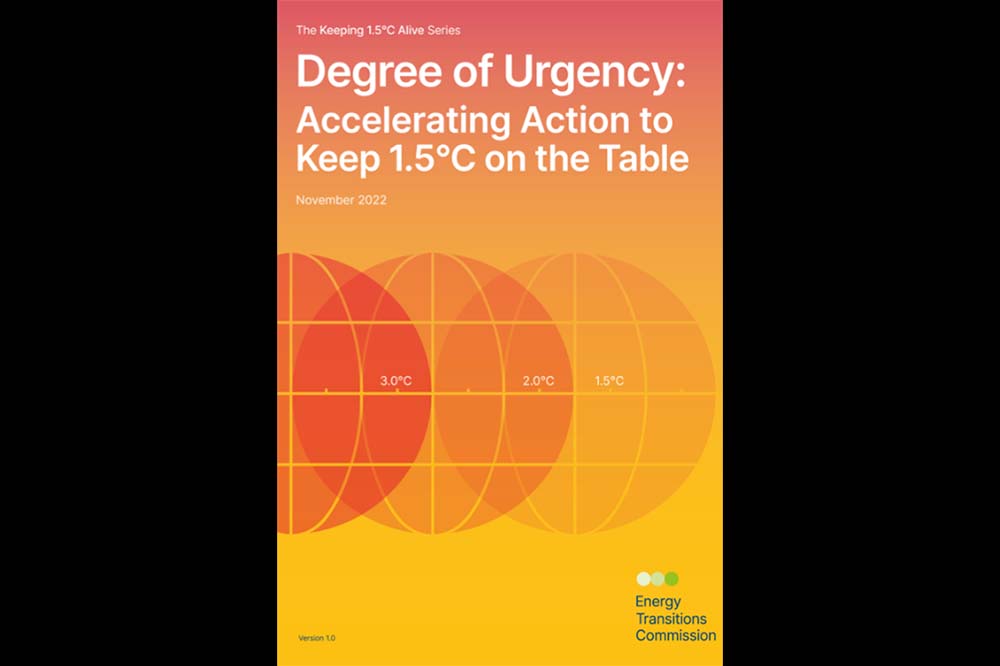
LONDON: Despite positive progress at COP26, current country pledges and commitments, even if fully implemented, still do not put the world on a trajectory to limit global warming to 1.5°C. If the world is to have even a 50 per cent chance of meeting that objective, COP27 must act as a catalyst to turn broad national commitments into specific actions and pave the way to more forceful measures to phase-out coal and end deforestation.
The economic and political situation ahead of COP27 is highly challenging. In addition to lingering pressures resulting from the Covid 19 pandemic and supply chain disruptions, the world now faces record energy and high food prices in many regions resulting from the war in Ukraine. Together these are leading to high inflation, lower growth and risks of recession in many countries.
There is a danger that energy security and short-term economic pressures, together with geopolitical tensions, will divert national and international attention from climate change-related issues. But many of the actions needed to build greater energy security could also drive a faster transition to a low-carbon economy, as described in the ETC's paper Energy Security Through Accelerated Transition. Despite the global geopolitical and macroeconomic headwinds, there is some evidence of progress on climate commitments.
Keeping 1.5°C on the table Some voices are challenging whether a 1.5°C trajectory is still feasible. However, each 0.1°C rise above 1.5°C will have hugely significant climate change impacts. The world must continue to aim for this target, and to ensure that any overshoot of it is as low as possible. Both full implementation of COP26 commitments and further progress at COP27 are therefore essential if the world is to have a chance of limiting global warming to 1.5°C. "Despite the current global economic and political challenges, we must keep focused on the global crises presented by climate change. Each 0.1 °C rise above 1.5°C will have a hugely significant impact. Many of the actions needed to build greater energy security could also drive a faster transition to a more resilient and stable low-carbon economy. Both full implementation of COP26 commitments and further progress at COP27 are therefore essential if the world is to have a 50-50 chance of limiting global warming", commented Adair Turner, Chair, Energy Transitions Commission.
3 priority areas for accelerated progress Against this backdrop the ETC's new report Degree of Urgency: Accelerating Action to Keep 1.5°C on the Table highlights three priority areas for accelerated progress:
Progress at COP26 but still an 'ambition gap' Despite positive momentum at COP26, an 'ambition gap' remains - current country pledges (NDCs) and commitments do not yet put the world on a 1.5°C trajectory. The formal country pledges (NDCs) and net-zero targets coming out of COP26 put the world on a pathway to above 2°C of warming. Although since then 24 countries have submitted updated NDCs, only Australia's makes a material impact on closing the emissions gap in 2030. COP26 also produced a series of sector agreements - including across deforestation, methane, and coal phase out - by countries and private participants that, if fully realised, could put the world on a pathway towards 1.8°C. However, the vast majority are yet to translate into formal country commitments, and critical agreements such as ending deforestation by 2030 are severely underfinanced.
Positive developments but still an "implementation gap" Despite encouraging developments in policy and technology, the world is also facing an 'implementation gap' between pledged targets and on-the-ground progress. This year there has been substantial policy action in the EU, US and China which has started to bridge the implementation gap, with ambitious targets (and strong prospects for implementation) set out in the REPowerEU package, the US Inflation Reduction Act, and in China's 14th Five-Year-Plan.
Keeping 1. 5°C Alive - what can be done? The world has a dwindling carbon budget of 1.5°C (500 Gt from 2020, 420 Gt from the beginning of 2022), so the time to act is running out. Despite the good news on the developed country and China's commitments and implementation, the current numbers do not add up to 1.5°C - under a full implementation trajectory, developed countries, China and India alone would likely overshoot the carbon budget needed to "keep 1.5°C alive". To square the objectives of global emissions reductions and economic development needs in emerging and developing economies, it will be necessary that all countries - but in particular the developed economies and China - at the very least achieve and ideally overachieve or increase emissions reduction commitments. Doing this will drive technological progress which will reduce mitigation costs across the world. "The ETC highlights critical actions for nations and companies if the world is to stand any chance of limiting global warming to 1.5°C. Rallying global leadership is at the heart of the Race to Resilience and the Race to Zero campaigns; and the ETC's recommendations demonstrate that it is technically and economically feasible to get us back on track through the power of collaboration. Momentum-building is one thing, but it is now crucial that we pivot to rapid delivery for what's left of the 2020s," remarked Nigel Topping, the UN Climate Change High-Level Champion for the UK. Across all areas, ambitious policy action can lead the way, but we identify two key additional drivers of action: - The need to tackle emissions from agriculture, forests and other land-use sectors, and in particular methane emissions and CO2 emissions from deforestation which result from red meat consumption: fixing these will require either shift in diet or technological changes such as the development of synthetic meat. - And the need for a large scale up in financing to phase-out coal, end deforestation and develop large-scale carbon dioxide removals soon. "In the year since COP26 where national priorities have appeared to drift away from climate, a stocktake of progress on the ground reveals a mixed picture. The rollout of renewables and electric vehicles is rapid and rising, and there is also optimism around progress in heavy industry and progressing energy efficiency. However, this alone is not enough and progress is urgently required in reducing methane emissions, early coal phase-out and ending deforestation," said Mike Hemsley, Deputy Director, Energy Transitions Commission. Whilst both high-income and developing countries can do more to accelerate their own emissions reductions, two further options exist that can accelerate progress:
Keeping 1.5°C on the table Some voices are challenging whether a 1.5°C trajectory is still feasible. However, each 0.1°C rise above 1.5°C will have hugely significant climate change impacts. The world must continue to aim for this target, and to ensure that any overshoot of it is as low as possible. Both full implementation of COP26 commitments and further progress at COP27 are therefore essential if the world is to have a chance of limiting global warming to 1.5°C. "Despite the current global economic and political challenges, we must keep focused on the global crises presented by climate change. Each 0.1 °C rise above 1.5°C will have a hugely significant impact. Many of the actions needed to build greater energy security could also drive a faster transition to a more resilient and stable low-carbon economy. Both full implementation of COP26 commitments and further progress at COP27 are therefore essential if the world is to have a 50-50 chance of limiting global warming", commented Adair Turner, Chair, Energy Transitions Commission.
3 priority areas for accelerated progress Against this backdrop the ETC's new report Degree of Urgency: Accelerating Action to Keep 1.5°C on the Table highlights three priority areas for accelerated progress:
- Closing the 'ambition gap' via more ambitious country targets, with strengthened NDCs (Nationally Determined Contributions) which reflect both country-specific actions and the potential impact of sectoral commitments agreed at Glasgow and subsequently.
- Closing the 'implementation gap' via targeted policies and company actions to drive further real-world progress across six critical sectors (methane, deforestation, power, road transport, heavy industry, and energy efficiency).
- Closing the 'financing gap' in particular to support middle and low-income countries to peak and then reduce emissions as soon as possible; in total at least $300 billion per annum could be required to support early coal phase-out, and end deforestation, and carbon dioxide removals in a scenario where sufficient action from policy and industry isn't taken. This funding should come from corporates in voluntary carbon markets, philanthropic capital, hybrid payment and investment instruments, and intergovernmental transfers of climate-related funding from developed to developing countries.
Progress at COP26 but still an 'ambition gap' Despite positive momentum at COP26, an 'ambition gap' remains - current country pledges (NDCs) and commitments do not yet put the world on a 1.5°C trajectory. The formal country pledges (NDCs) and net-zero targets coming out of COP26 put the world on a pathway to above 2°C of warming. Although since then 24 countries have submitted updated NDCs, only Australia's makes a material impact on closing the emissions gap in 2030. COP26 also produced a series of sector agreements - including across deforestation, methane, and coal phase out - by countries and private participants that, if fully realised, could put the world on a pathway towards 1.8°C. However, the vast majority are yet to translate into formal country commitments, and critical agreements such as ending deforestation by 2030 are severely underfinanced.
Positive developments but still an "implementation gap" Despite encouraging developments in policy and technology, the world is also facing an 'implementation gap' between pledged targets and on-the-ground progress. This year there has been substantial policy action in the EU, US and China which has started to bridge the implementation gap, with ambitious targets (and strong prospects for implementation) set out in the REPowerEU package, the US Inflation Reduction Act, and in China's 14th Five-Year-Plan.
Keeping 1. 5°C Alive - what can be done? The world has a dwindling carbon budget of 1.5°C (500 Gt from 2020, 420 Gt from the beginning of 2022), so the time to act is running out. Despite the good news on the developed country and China's commitments and implementation, the current numbers do not add up to 1.5°C - under a full implementation trajectory, developed countries, China and India alone would likely overshoot the carbon budget needed to "keep 1.5°C alive". To square the objectives of global emissions reductions and economic development needs in emerging and developing economies, it will be necessary that all countries - but in particular the developed economies and China - at the very least achieve and ideally overachieve or increase emissions reduction commitments. Doing this will drive technological progress which will reduce mitigation costs across the world. "The ETC highlights critical actions for nations and companies if the world is to stand any chance of limiting global warming to 1.5°C. Rallying global leadership is at the heart of the Race to Resilience and the Race to Zero campaigns; and the ETC's recommendations demonstrate that it is technically and economically feasible to get us back on track through the power of collaboration. Momentum-building is one thing, but it is now crucial that we pivot to rapid delivery for what's left of the 2020s," remarked Nigel Topping, the UN Climate Change High-Level Champion for the UK. Across all areas, ambitious policy action can lead the way, but we identify two key additional drivers of action: - The need to tackle emissions from agriculture, forests and other land-use sectors, and in particular methane emissions and CO2 emissions from deforestation which result from red meat consumption: fixing these will require either shift in diet or technological changes such as the development of synthetic meat. - And the need for a large scale up in financing to phase-out coal, end deforestation and develop large-scale carbon dioxide removals soon. "In the year since COP26 where national priorities have appeared to drift away from climate, a stocktake of progress on the ground reveals a mixed picture. The rollout of renewables and electric vehicles is rapid and rising, and there is also optimism around progress in heavy industry and progressing energy efficiency. However, this alone is not enough and progress is urgently required in reducing methane emissions, early coal phase-out and ending deforestation," said Mike Hemsley, Deputy Director, Energy Transitions Commission. Whilst both high-income and developing countries can do more to accelerate their own emissions reductions, two further options exist that can accelerate progress:
- Flows of funding in the form of investments and payments from public and private sector to enable lower-income countries to move faster than technology & policy sharing alone would enable.
- Faster scaling and increased contribution of negative emissions solutions alongside rapid and deep cuts to emissions, as highlighted by the ETC in Mind the Gap: How Carbon Dioxide Removals Must Complement Deep Decarbonisation to Keep 1.5°C Alive
Published Date: November 2, 2022, 12:00 am
Post Comment
E-Magazine
RELATED International



.jpg)

.jpg)